Content
- Definition of subendocardial ischemia
- Development mechanism
- Causes
- Symptoms
- Diagnostics
- Preparation for the examination
- ECG
- Decoding the results, signs of subendocardial ischemia on the ECG
- Treatment
- Antiplatelet drugs
- Clopidex
- Zylt
- Cholesterol-lowering drugs (statins)
- Atorvastatin
- Rosuvastatin
- Calcium antagonists
- Diltiazem
- Nifedipine
- Antianginal drugs from the group of nitrates
- Nitroglycerine
- Izacardin
- Lifestyle correction
- Possible complications, prognosis
- Ischemia video
Subendocardial ischemia is considered one of the most common cardiac causes of sudden death among men and women over 45 years of age. A distinctive feature of the disease is the slow progression of irreversible changes in the tissues of the myocardium, the occurrence of systemic disorders in the work of this part of the heart muscle. Subendocardial ischemia is determined using ECG, isotopic diagnostics of the heart, echocardiography after stress loads on the patient's cardiovascular system.
Definition of subendocardial ischemia
Subendocardial ischemia is a pathological condition of the myocardium that occurs due to disturbances in the blood supply of its tissues. Coronary vessels run along the entire area of the epicardial surface of the heart muscle, and then penetrate deep into the myocardium.
The main arteries are connected in series with the general blood flow system of the epicardial, middle, and subendocardial segments of the heart. The last part of the heart muscle is the most distant from the coronary vessels. The subendocardial layer experiences maximum stress during the period of contractile activity of the heart and needs more oxygen.
Development mechanism
The subendocardial region of the heart muscle is the most susceptible to the development of coronary artery disease. This is due to the fact that the left wall of the ventricle is characterized by a greater thickness of tissues. Violations of blood supply in the myocardium leads to the occurrence of degenerative processes in its subendocardial layer. In this case, the wall of the right ventricle has a smaller thickness, much easier and faster irrigated with blood coming from the coronary arteries.
The subendocardial segment of the myocardium is considered a weak and vulnerable area of the human cardiovascular system, which is susceptible to the development of coronary artery disease due to circulatory disorders. The severity of the pathology depends on the severity of the deficiency of oxygen and other nutrients that enter the myocardium along with the blood.
Causes
The main reason for the development of subendocardial ischemia is atherosclerotic changes in the internal structure of the coronary vessels. One of the arteries, which carries out blood supply to the myocardium, narrows in the lumen, or is clogged with plaques. Deficiency of blood supply negatively affects the functional state of the heart muscle, but the subendocardial region, which needs more blood and oxygen, suffers first.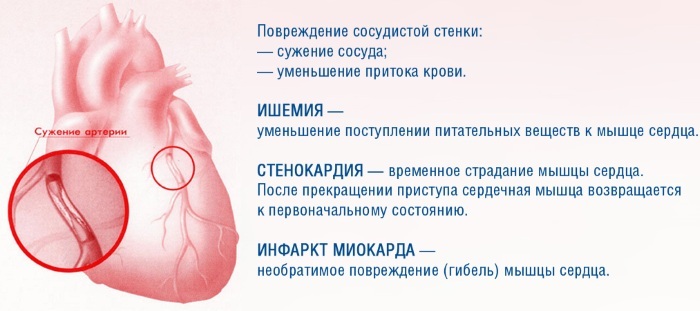
There are the following predisposing factors that cause subendocardial ischemia:
- maintaining a sedentary lifestyle, when minimal physical activity is created on the tissue of the heart muscle;
- diabetes;
- hypertension, accompanied by a stable preservation of blood pressure, the indicators of which are higher than the level of 140 by 90 units;
- hereditary predisposition to ischemic disease and myocardial infarction (for example, if one of the person's parents had previously died of this disease at the age of less than 55);
- overweight with progressive obesity;
- smoking;
- chronic alcoholism.
Subendocardial ischemia is a dangerous condition of the heart myocardium that can be diagnosed with an exercise ECG. Prevention and effective therapy of this disease is impossible without the elimination of the above risk factors.
Symptoms
The first signs of subendocardial ischemia are easily confused with most other cardiac disorders.
This myocardial pathology is manifested by the following symptoms:
- compressive pain in the chest, the intensity of which ranges from minor discomfort to severe burning;
- feeling of prolonged pressure on the surface of the chest;
- feeling of lack of air, the appearance of which is paroxysmal;
- shingles pain syndrome, which covers the area of the body from the left scapula to the upper abdominal cavity, where the solar plexus is concentrated.
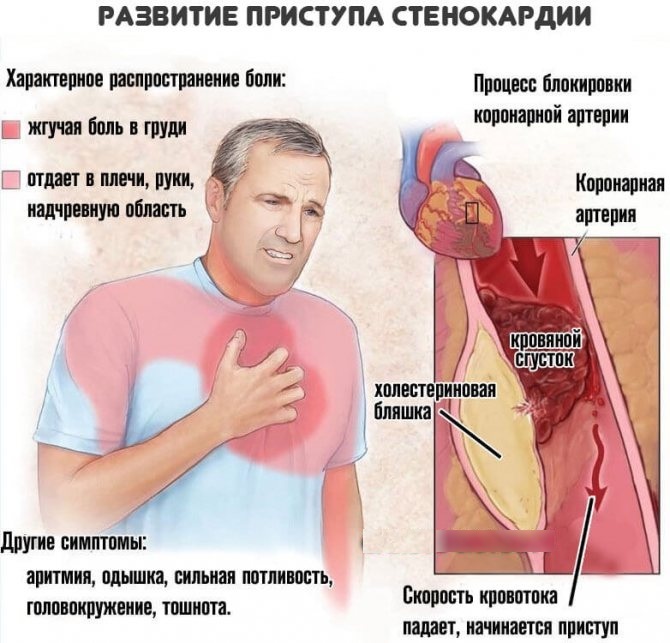
The most atypical symptom of subendocardial ischemia is pain that is localized in the mandible. In this case, a person may experience severe discomfort in the muscles of the left arm, general physical fatigue, and decreased performance. The most dangerous manifestation of subendocardial ischemia is the sudden onset of myocardial infarction. For example, if the patient previously ignored the symptoms of this pathology, did not undergo diagnosis, and also did not engage in its treatment.
Diagnostics
Subendocardial ischemia on the ECG is manifested by ST segment depression. Signs of a painful state of the myocardium are determined after decoding the results of an electrocardiogram.
Preparation for the examination
ECG is an informative method of hardware diagnostics that displays the functional state of the heart muscle.
To obtain the most objective data before the examination, the following preparation rules must be observed:
- during the day before the diagnosis, exclude any physical activity and psycho-emotional overstrain;
- you need to get enough sleep before going to the hospital;
- on the day of the ECG, it is not recommended to overeat, eat too much fatty foods;
- on the surface of the skin of the chest, you can not apply oil-based cosmetics, use a variety of lotions and creams;
- the last cigarette should be smoked no later than 30-40 minutes. before the examination (otherwise, the nicotine contained in tobacco products can provoke a spasm of the blood vessels, which will be displayed on the ECG results).
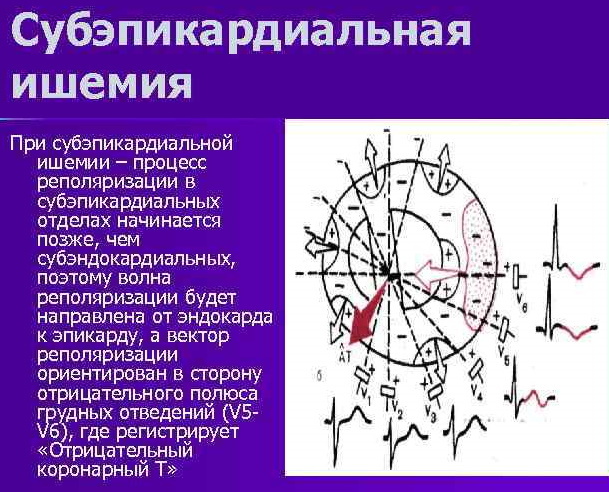
Do not perform any physical exercise before diagnosing a heart. You should arrive at the hospital 10-15 minutes in advance. before the appointed time of the examination. The cardiovascular system should not experience any critical stress.
ECG
Subendocardial ischemia on the ECG is diagnosed by a cardiologist, who records any changes in the rhythmic activity of the patient's heart. Performing an electrocardiogram while the patient is at rest does not allow determining the severity of coronary artery disease.
In this case, the ECG method is used in combination with the following types of stress loads:
- quick work on an exercise bike, after which the patient immediately lies down on the couch to take an electrocardiogram;
- the introduction of drugs that stimulate the functional activity of the heart muscle (for example, Dobutamine);
- isotopic study of the heart muscle with the simultaneous creation of physical activity.
As additional stress for the cardiovascular system, the patient may be asked to do squats, push-ups from the floor, and quickly walk around the perimeter of the room.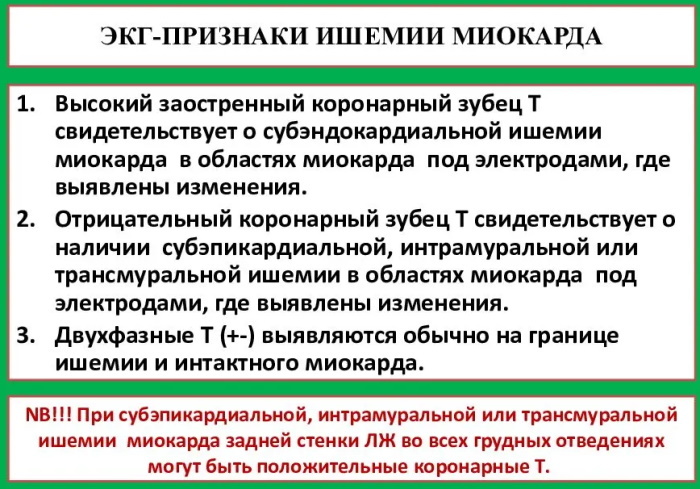
Directly the electrocardiogram itself is performed as follows:
- After creating a physical load on the cardiovascular system, the patient lies with his back on the surface of the couch.
- The patient's torso and legs are freed from clothing.
- A cardiologist attaches on the surface of the chest, wrists and ankle patient special electrical sensors that record the rhythmic activity of the heart and blood vessels.
- An electrocardiograph is launched, which collects information about the performance of the patient's cardiovascular system.
The average duration of the diagnostic procedure is 10 to 15 minutes. Depending on the general condition of the patient, during one examination, a cardiologist can conduct an ECG before and after physical exertion. The received data are recorded in electronic and paper versions. Based on the results of ECG decoding, the cardiologist decides on the direction of the patient for an additional diagnostic method in the form of coronary angiography.
Decoding the results, signs of subendocardial ischemia on the ECG
Subendocardial ischemia on the ECG is manifested by changes in the work of the heart and arterial vessels. During the interpretation of the examination results, special attention is paid to the ST segment and the T wave, the indicators of which are displayed in the form of wavy lines. Using the method of electrocardiogram with physical activity, it is possible to determine the initial stages of IHD of the subendocardial type, as well as more advanced forms of the disease.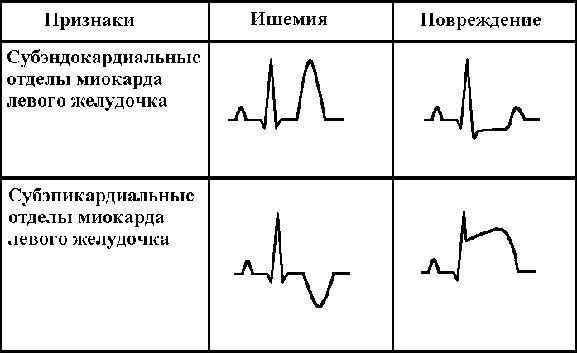
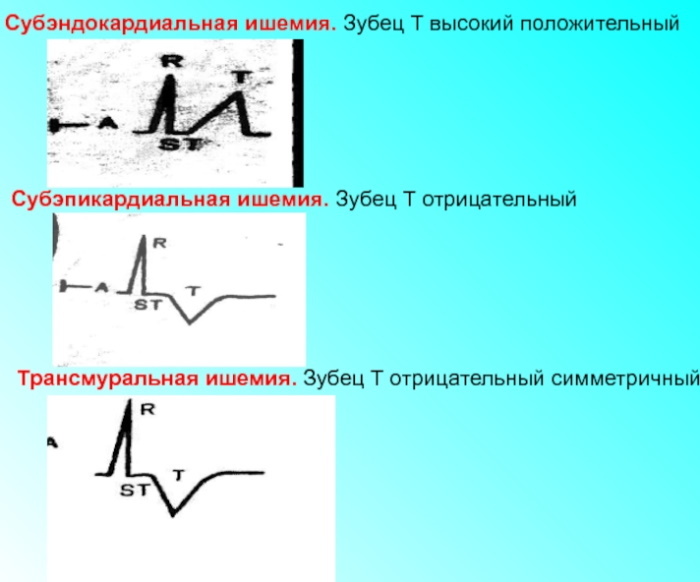
The table below details the procedure for interpreting ECG results to confirm or deny subendocardial ischemia.
| Diagnostic indicators | Decoding electrocardiogram data |
| ST segment | Subendocardial ischemia is defined by the characteristic presence of ST-segment depression. This indicator indicates a severe violation of blood flow in the tissues of the myocardium. In this case, it is the subendocardial portion of the heart muscle that is located in the affected area. If during the decoding of the ECG results it was found that the ST segment is in a state of elevation, then this patient has pathological signs of subepicardial or transmural myocardial ischemia. |
| T wave | On the results of an electrocardiogram, the T wave shows physiological changes in the tissues of the heart myocardium. These fluctuations are especially clearly visible in the presence of coronary circulation disorders. By the nature of the changes in the shape of the T wave, the severity of ischemic disease is determined. For example, if the shape of the T wave quickly takes on its former appearance, then this indicates that there are no necrotic changes in the tissues of the myocardium. In patients with signs of necrosis of the subendocardial area, the T wave retains an atypical shape for several months, and sometimes pathological changes in this indicator are diagnosed for years. |
 If the presence of ST segment depression always indicates acquired subendocardial ischemia of myocardial tissues, then the T wave is an indicator of pathological changes in this part of the heart. Only a practicing cardiologist with sufficient experience can make a qualitative interpretation of the results of an ECG with physical activity. Additional signs of subendocardial ischemia are blockages and arrhythmic disturbances in the work of the heart.
If the presence of ST segment depression always indicates acquired subendocardial ischemia of myocardial tissues, then the T wave is an indicator of pathological changes in this part of the heart. Only a practicing cardiologist with sufficient experience can make a qualitative interpretation of the results of an ECG with physical activity. Additional signs of subendocardial ischemia are blockages and arrhythmic disturbances in the work of the heart.
Treatment
The treatment regimen for subendocardial ischemia is selected individually, depending on the diagnostic results and the general well-being of the patient. Taking medications should be accompanied by the prevention of pathological changes in the myocardium, as well as the elimination of the main causes that caused coronary atherosclerosis.
Antiplatelet drugs
The action of antiplatelet drugs is aimed at preventing blockage of coronary arteries, restoring full blood supply to all parts of the myocardium.
Clopidex
Clopidex is a tablet-form drug produced by the Turkish pharmaceutical company Bilim Pharmaceuticals. This medication has anti-thrombotic properties, prevents the occurrence of myocardial infarction and the onset of sudden death. Clopidex is taken in a dosage of 0.5 - 1 tablet once a day. The dosage regimen with this medication can be changed by the attending physician depending on changes in the functional state of the myocardium. The average cost of the drug Clopidex is from 345 to 476 rubles. for 30 tablets.
Zylt
Zilt is an antiplatelet agent produced by the domestic pharmaceutical company Krka-RUS LLC. The form of release of the drug is pink tablets. The drug Zilt is prescribed for the treatment and prevention of ischemic disease, myocardial infarction, and pathologies of blood circulation in the coronary vessels.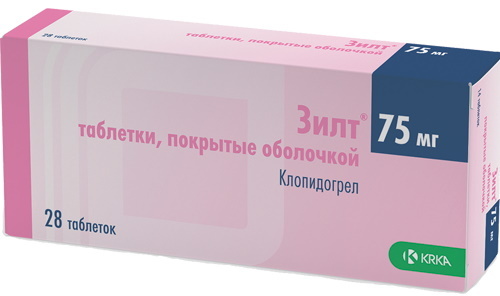
The dosage regimen for this medication is determined individually by the doctor. To enhance the antiplatelet effect in combination with the drug Zilt, drugs based on acetylsalicylic acid are used. The average cost of this medication is from 501 to 526 rubles. for 28 tablets.
Cholesterol-lowering drugs (statins)
Low molecular density cholesterol-lowering drugs must be taken continuously for the rest of your life. Lipid-lowering medications prevent the formation of cholesterol plaques in the lumen of arterial vessels.
Atorvastatin
The drug Atorvastatin is available in the form of tablets with the active ingredient atorvastatin with a dosage of 10 mg. The manufacturer of this medication is ZAO Biocom, RF. The initial dose of this drug is 1 tablet 1 time per day. If necessary, the therapeutic dosage can be increased by 8 times. Every 2-4 weeks, all patients taking this medication must donate blood for lipid testing. The average cost of the lipid-lowering agent Atorvastatin is from 135 to 184 rubles. for 30 tablets.
Rosuvastatin
Rosuvastatin is a safe medication for lowering blood cholesterol levels. Lipid-lowering tablets are produced by the Russian pharmaceutical company ALSI Pharma JSC. The active substance of this medication is rosuvastatin calcium at a dosage of 5 mg. The dosage regimen for this drug involves taking it in the amount of 1-2 tablets 1 time per day. 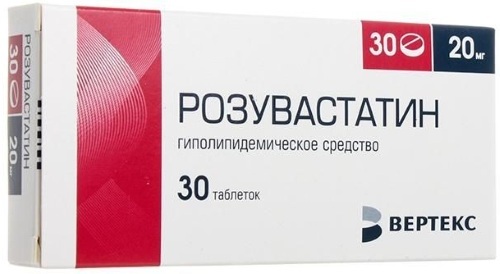 The average cost of the drug Rosuvastatin is from 156 to 294 rubles. for 30 tablets.
The average cost of the drug Rosuvastatin is from 156 to 294 rubles. for 30 tablets.
Calcium antagonists
Calcium antagonists are a separate group of drugs that slow down the flow of calcium ions into muscle tissue cells. In the treatment of subendocardial ischemia, they are used as agents that normalize the rhythmic activity of the heart, improve blood circulation in the coronary vessels.
Diltiazem
Diltiazem is an effective drug based on the active substance diltiazem hydrochloride with a dosage of 90 mg in 1 tablet. This medication is produced by the Macedonian pharmaceutical company "Alkaloid". This drug is taken in a dosage of 1 tablet 2-3 times a day. In case of therapeutic necessity, the indicated dose can be doubled. The average cost of the drug Diltiazem is from 91 to 122 rubles. for 30 tablets.
Nifedipine
Nifedipine is a potent calcium channel blocker manufactured by Valenta Pharmaceuticals PJSC. The active substance of this medication is the chemical compound nifedipine at a dosage of 10 mg. Taking this drug is prescribed 1 tablet 3-4 times a day. The average cost of Nifedipine is 28 rubles. for 50 tablets.
Antianginal drugs from the group of nitrates
Medicines from the group of antiangial drugs based on nitrates are taken for a quick expanding the lumen in the coronary vessels and providing the myocardium with an additional amount of oxygen.
Nitroglycerine
Nitroglycerin is a cardiological medicine produced by the Russian pharmaceutical company Samaramedprom. 1 tablet of this drug contains 400 mcg of nitroglycerin. 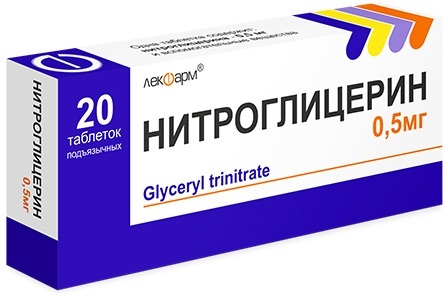 This drug is used for the prevention and relief of acute attacks of angina pectoris, which are caused by coronary artery disease. Nitroglycerin is taken in a dosage of 1-2 tablets at the time of the onset of shortness of breath, cardiac arrhythmias, dizziness. The average cost of this medication is about 110 rubles. for 40 tablets.
This drug is used for the prevention and relief of acute attacks of angina pectoris, which are caused by coronary artery disease. Nitroglycerin is taken in a dosage of 1-2 tablets at the time of the onset of shortness of breath, cardiac arrhythmias, dizziness. The average cost of this medication is about 110 rubles. for 40 tablets.
Izacardin
Izacardin is a concentrate for self-preparation of an injection solution. 1 ampoule of this medication contains 10 mg of the active substance isosorbide dinitrate. Izakardin is produced by the Russian company Ozone LLC. A concentrate-based infusion solution is administered intravenously or injected into the oral cavity. The dosage regimen and the timing of therapy are determined individually by the attending physician. The average cost of the drug Isacardin is from 697 to 749 rubles. for 10 ampoules with concentrate.
Lifestyle correction
Subendocardial ischemia on the ECG is manifested by focal changes in the densest tissues of the myocardium. As the disease progresses, large areas of the heart muscle die. Lifestyle correction is the main rule of effective prevention of coronary artery disease.
In this case, the following recommendations must be followed:
- give up drinking and smoking;
- to live an active lifestyle;
- not to travel by transport, but to walk more, training all segments of the cardiovascular system;
- control cholesterol and blood sugar levels;
- regularly undergo scheduled examinations by a cardiologist;
- do not eat too fatty, fried, smoked food, since the substances contained in its composition negatively affect the state of the heart muscle and blood circulation in the coronary vessels;
- timely treat concomitant diseases that contribute to the onset of ischemic disease;
- avoid stress and psycho-emotional overstrain;
- provide the body with moderate physical activity.
Corrective changes in the lifestyle of a person with subendocardial ischemia should be agreed with a cardiologist. The doctor of this specialization independently determines what level of physical activity of the patient is optimal for the prevention of coronary artery disease.
Possible complications, prognosis
In the absence of effective prevention and treatment of subendocardial ischemia, the patient will die from myocardial infarction. The risk of having a heart attack increases dramatically during moments of physical exertion. Correction of lifestyle, regular intake of medications helps to curb degenerative changes in the tissues of the myocardium.
Subendocardial ischemia is a dangerous type of ischemic heart disease that occurs due to atherosclerotic changes in large coronary vessels. The disease is chronic with slow progression. The mechanism of development of pathology is a violation of blood supply in the tissues of the subendocardial region of the myocardium.
This segment of the heart muscle needs the most oxygen. Deficiency of blood supply leads to local tissue necrosis. Diagnosis of cardiac disease is carried out on an ECG with exercise. Based on the results of the study, an adequate therapy regimen is selected.
Ischemia video
ECG - heart attack and ischemia:



